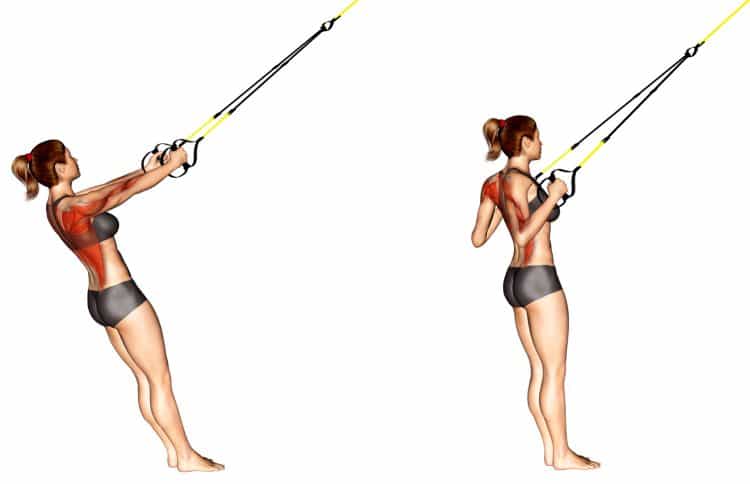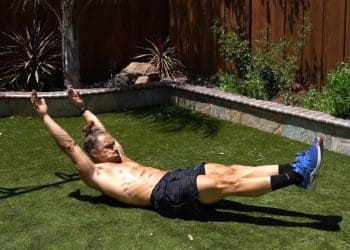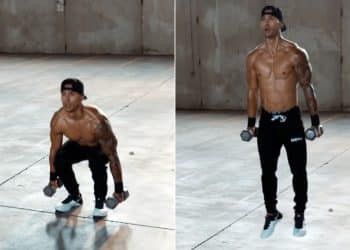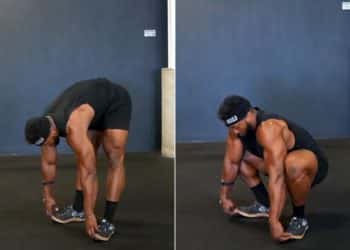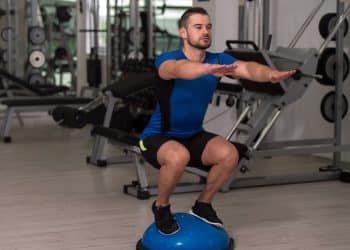The predecessor technique to its more advanced, inverted counterpart, suspension rows are the default mode back movement for beginner exercisers. For those who lack much pulling strength or are toting extra baggage in your trunk, or fat pounds, suspension rows reduce the training load as much or as little as needed. That way you can focus on sculpting a sexy posterior while burning calories in the process.
Then when you’re ready to step up your bodyweight back and biceps gains, we’ll spawn more challenging suspension row variations that will test even the most powerful amongst them.
So make sure not to skip over any part of this suspension row exercise guide so you don’t miss out on the best training tips, video tutorials, and programming recommendations.
Muscles Worked During The Suspension Row
This version of the row works all of the non-mirror muscles as well as the front-facing biceps and forearms. But let’s get more specific about the muscular benefits that should be expected from the suspension row.
Infraspinatus – The second letter in “SITS”, which represents the quad group of rotator cuff muscles, supraspinatus, infraspinatus, teres minor, and subscapularis, the infraspinatus assists the other three muscles in stabilizing the shoulder joint, enabling it to move in various positions.
Level Up Your Fitness: Join our 💪 strong community in Fitness Volt Newsletter. Get daily inspiration, expert-backed workouts, nutrition tips, the latest in strength sports, and the support you need to reach your goals. Subscribe for free!
Latissimus Dorsi – The largest and most impressive muscle in your back, it’s no wonder the latissimus dorsi is a star attraction in bodybuilding competitions. While you don’t need a massive of wings, stronger lats are not just a showpiece but they stabilize and move the scapula when you perform multi angle pulls.
Teres Major – What elfs are to santa, the teres major is to your lats. If you got the reference, teres major, a small scapulohumeral muscle, helps the larger lats to move the shoulders many ways.
Teres Minor – The “T” is SITS as one of the muscles that contribute to rotator cuff function, teres minor is a key muscle in all pulling motions.
Trapezius Lower Fibers – The back has no shortage of powerful muscles that move the scapula. The lowermost of three parts making up the trapezius shaped group of back muscles, lower fibers create downward movement of the shoulder blades.
Trapezius Middle Fibers – Move slightly north above the lower fibers and the middle traps pull the shoulder blades back in retraction. This helps create good movement alignment for optimal back activation.
Trapezius upper fibers – Planted across the upper back with fibers that run to the occipital head bone. Upper traps lift your scap north.
Brachialis – The brachialis lies halfway along the outside of your biceps in the upper arm, and drops through the elbow, where it powerfully flexes the arm. Best developed using a neutral grip during curls and pulls, you’ll see better arms aesthetics when this muscle is developed.
Brachioradialis – A forearm and upper arm muscle, brachioradialis fibers create flexion at the elbow.
Biceps – If you want jacked biceps, learn to love the row. A twin-headed muscle that bends the elbow and moves the arm forward, they’ll get plenty of workout during rows.
Deltoid Posterior – The most ignored head of the three shoulder muscles due to its rear facing location, deltoid posterior helps your pulling strength, posture, and maintaining muscular balance. You will never have a complete looking physique with underdeveloped rear delts. As they create 3D aesthetics, and prevent the “flat” look.
Core – The more superficial eight-pack muscles, deeper lifting stabilizers, and back muscles all create a strong and impact ready core. In the pull-up, it’s transverse abdominis that act like a weightlifting belt to keep your trunk tight, and rigid against opposing forces.
Hips – Including the butt and surrounding muscles, you’d be a fool to think you can do suspension rows without strong hips that help stabilize your body.
How To Do The Suspension Row
Before you initiate the first pull, make sure your straps and positioning are appropriate for your strength level and goals. Your setup will be just as the important as the movement itself because the gains are in the details. Make sure to follow both the written instructions and video demonstration for key form tips, movement execution, and programming advice.
Steps
- Secure your suspension straps to an overhead object. When standing upright, the strap handles should hang just above the knee, give or take a few inches.
- Next grip your handles with the palms facing in or down, then walk back away from the anchor point until the straps are tight.
- Then straighten your arms and drop back, letting the straps hold you up while keeping your body in a straight line from head to heel.
- Before your first rep, squeeze your core and glutes, pull your shoulders halfway back, lift the chest, activate your lats, and grip the handles tight to engage your back muscles.
- Now bend your arms and pull yourself up as high as you can slow and controlled.
- Slowly straighten the arms to drop back down into the starting pose, and open the lats to stretch your upper posterior muscles.
- Knock out as many reps as planned or go to absolute muscular failure.
- When you’re finished walk your feet back, standing completely upright, and release the handles. Then do another two sets to wrap up your suspension row workout, and move on to another back exercise.
Here’s a YouTube tutorial with a demonstration by a reputable trainer.
Tips
- Make sure to inspect both your strap secureness and the floor to ensure your safety during training.
- Don’t forget to squeeze the handles firmly to activate more back fibers, but also to keep your form tight, and muscles strong.
- Start your first workouts more upright, and gradually walk your feet forward as your strength capabilities allow. Depending on where you’re at in your training, this strength progression could occur over weeks, and months.
This Exercise
- Target muscle group: Back
- Type: Hypertrophy and strength
- Mechanics: Compound
- Equipment: Suspension straps and anchor point
- Difficulty: Beginner
Benefits Of The Suspension Row
Anyone can walk up to suspension straps and immediately benefit from a standing rowing variation. In fact, this beginner level technique is good enough to be a fundamental movement for those who want to up their overall fitness. These are the best reasons you need suspension rows in your back workouts.
Low intensity, beginner-friendly bodyweight back exercise
That’s a mouthful, yet it’s so true of the suspension row. Akin to what a wall push-up is to the most novice exercisers who want a stronger chest and triceps, suspension rows are the same but for your back and biceps. The taller you are, the easier the exercise, and hence, the effort required, which can make it very low intensity, which is especially beneficial for those who also want to build their cardiovascular fitness.
Fundamental and functional
What’s fundamental about the suspension row? Well, for one, you’re standing while doing it. That itself should be a staple, must-have element of every training program.
It’ll train you to use several muscles at once which burns more calories, build your coordination, test your balance and stability, and identify muscle imbalances. And due to its low impact nature, anyone can do it, so long they understand their strength capabilities, and have decent grip strength to hold themselves up.
Tighten up and reinforce your posture
If we took a poll on the more prioritized side of the body, we’d bet the anterior muscles leave your backside in the rear. And it’s especially bad when you train the chest hard, yet only do one or two exercises for the back with low intensity. Then you don’t do any accessory or postural work to boot, and are always looking down at your devices. This is bad news for the muscles in your back, shoulders, and head.
Level Up Your Fitness: Join our 💪 strong community in Fitness Volt Newsletter. Get daily inspiration, expert-backed workouts, nutrition tips, the latest in strength sports, and the support you need to reach your goals. Subscribe for free!
We’re not saying suspension rows are the solution to bad posture. But it does help strengthen your back muscles. And the more you do it and progress, the better for you in the long term.
Common Mistakes During The Suspension Row
A simple routine technique for more experienced exercisers, beginners will often make these common mistakes.
Loose form
We don’t expect a novice to have perfect form as it’s something that is usually perfected over time. However, if you have a mental or written checklist it’s going to help you create good habits faster. Because, more than likely, the exercise is going to feel correct, and you’ll notice how much more efficient you are.
So what are we talking about here with having good form? It’s simple and we won’t complicate it.
Keeping your body straight, squeezing your midsection, pinning the shoulders partially back, lifting the chest, and activating the lats. No letting the hips sink, or being a hunchback.
Going too fast
The key to a good suspension row, especially for beginner exercisers, is to go nice and slow, and pay attention to what your joints and muscles are doing. The left and right arm should feel symmetrical in their movement and with an equal amount of muscle tension.
Pulling too fast can mask potential differences from one side to the other, and it can also turn the movement into an arm exercise, where you fail to engage the back muscles optimally.
Sticking your elbows out
If you were doing face pulls or rear delt rows, this would be fine. But not when the goal is to train your back muscles. And actually similar to your pressing form, the arms should be neither pinned to your sides or flared out wide. The reason for this is to create the strongest body position and angle, while being able optimally activate the muscles responsible for this specific movement.
Not properly inspecting your setup
A a more dangerous position than usual, suspension rows are performed at an angle where you’re leaning back. Not properly securing your straps or failing to inspect the floor can cause falls, and it could be very bad. So this is just a gentle reminder to be careful.
5 Variations and Alternatives Of The Suspension Row
It doesn’t get much easier than a suspension row when it comes to bodyweight pull muscle exercises.
Suspension weighted row
Suit up with a weighted vest or if you have a backpack, you can load it evenly with some weighted objects for a high intensity workout. Not only will you burn more calories doing this but you can take your strength, and consequently, muscle gains to the next level.
Suspension single arm row
The beautiful thing about suspension rows is you have endless options to implement progressive overload. Therefore, whether you’re a beginner or the most advanced, you’ll probably never outgrow the most challenging versions of strap pulls.
Let go of one handle and feel the immediate overload on one side. You’re essentially increasing the percentage of your body weight resistance with this easy modification. But there’s a key difference between using one or two arms. With the suspended single arm row, you have to resistance rotational forces, or stop yourself from twisting to either side.
Pro tip: Keep the shoulders and hips squared up to the anchor point, not allowing your point to rotate.
Suspension inverted row
If you’re serious about your progress, the goal should be to eventually end up with the back of your head as close to the floor as possible. With your posterior floating a few inches above the ground and body at full length, you’ll create more load for your back and arms to overhead.
Changing your body angle is the easiest way to increase or decrease resistance in a suspension row. Then if you need an upgrade, just prop your feet up onto something, wear a weighted vest, and switch to one arm only, in this position. We promise, very few will get to the point where suspension rows are too easy for them.
Here’s what the suspension inverted row setup looks like.
Bar row
Throw away the stability requirement, and just focus on the muscles themselves by performing rows on a Smith machine or barbell in a rack. It’s going to feel quite different and much less stressful as you don’t have to fight against shaky suspension straps. If you’re in a gym, this will likely be the more accessible option too.
Also called the Australian pull-up, we have the full guide to this variation here.
Home-friendly bodyweight row
We’ll offer you three at home methods that you can use to replicate a bodyweight row without suspension straps or a pull-up bar.
The first and in our opinion, the most convenient and safer option is to get underneath a sturdy table, and perform rows that way. Or you could also find two closely positioned countertops and bridge a strong broom or mop handles on both sides.
Another way, but you need to do it properly and we don’t really recommend it if you can choose another option, is close a bedsheet in the top of your door for a poor man’s suspension strap row. If you opt for this route, definitely stack lots of cushions on the floor so that you’ll fall onto a soft surface if your setup fails you.
FAQ’s
How many sets and reps should I do for suspension rows?
For any muscle training exercise, we always recommend a minimum of two sets. If you want to do more sets for one exercise, consider the total number of exercises per workout, total reps per set, intensity, and your training experience.
For example, if you do three or more back exercises per session, two high intensity sets per movement taken to muscular failure should be adequate. If you’re only doing the suspension row, or adding one more movement, then 3-4 challenging sets per move should give you adequate stimulation.
What is the advantage of using suspension straps?
Suspension trainers, like the popular TRX and other more affordable options offer a lightweight, portable, and versatile full body training tool that allows you to perform resistance based exercises and techniques without a gym or weights.
So these are the advantages over having a gym membership.
What type of suspension straps should I use?
While slightly pricier, you can’t go wrong with suspension straps from the TRX brand. Otherwise, there are many quality alternatives that offer similar benefits but at a cheaper price point.
Wrapping Up
Dip your toes into bodyweight rows with the suspension row variation aimed at the beginner exerciser. It won’t take long for your back and biceps to get stronger from this variation, and that’s no problem. Because it’s easily modifiable to suit even the toughest of them, and we show you how to do that in this training guide.
For suspension rows to be max effective, make sure to have a form checklist as explained in the article, and always inspect your setup to ensure both safety and training accuracy.
Interested in measuring your progress? Check out our strength standards for Face Pull, Pull Ups, Inverted Row.

